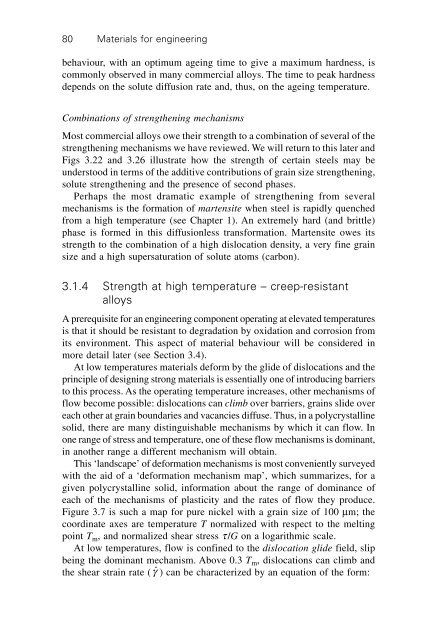Materials for engineering, 3rd Edition - (Malestrom)
You also want an ePaper? Increase the reach of your titles
YUMPU automatically turns print PDFs into web optimized ePapers that Google loves.
80<br />
<strong>Materials</strong> <strong>for</strong> <strong>engineering</strong><br />
behaviour, with an optimum ageing time to give a maximum hardness, is<br />
commonly observed in many commercial alloys. The time to peak hardness<br />
depends on the solute diffusion rate and, thus, on the ageing temperature.<br />
Combinations of strengthening mechanisms<br />
Most commercial alloys owe their strength to a combination of several of the<br />
strengthening mechanisms we have reviewed. We will return to this later and<br />
Figs 3.22 and 3.26 illustrate how the strength of certain steels may be<br />
understood in terms of the additive contributions of grain size strengthening,<br />
solute strengthening and the presence of second phases.<br />
Perhaps the most dramatic example of strengthening from several<br />
mechanisms is the <strong>for</strong>mation of martensite when steel is rapidly quenched<br />
from a high temperature (see Chapter 1). An extremely hard (and brittle)<br />
phase is <strong>for</strong>med in this diffusionless trans<strong>for</strong>mation. Martensite owes its<br />
strength to the combination of a high dislocation density, a very fine grain<br />
size and a high supersaturation of solute atoms (carbon).<br />
3.1.4 Strength at high temperature – creep-resistant<br />
alloys<br />
A prerequisite <strong>for</strong> an <strong>engineering</strong> component operating at elevated temperatures<br />
is that it should be resistant to degradation by oxidation and corrosion from<br />
its environment. This aspect of material behaviour will be considered in<br />
more detail later (see Section 3.4).<br />
At low temperatures materials de<strong>for</strong>m by the glide of dislocations and the<br />
principle of designing strong materials is essentially one of introducing barriers<br />
to this process. As the operating temperature increases, other mechanisms of<br />
flow become possible: dislocations can climb over barriers, grains slide over<br />
each other at grain boundaries and vacancies diffuse. Thus, in a polycrystalline<br />
solid, there are many distinguishable mechanisms by which it can flow. In<br />
one range of stress and temperature, one of these flow mechanisms is dominant,<br />
in another range a different mechanism will obtain.<br />
This ‘landscape’ of de<strong>for</strong>mation mechanisms is most conveniently surveyed<br />
with the aid of a ‘de<strong>for</strong>mation mechanism map’, which summarizes, <strong>for</strong> a<br />
given polycrystalline solid, in<strong>for</strong>mation about the range of dominance of<br />
each of the mechanisms of plasticity and the rates of flow they produce.<br />
Figure 3.7 is such a map <strong>for</strong> pure nickel with a grain size of 100 µm; the<br />
coordinate axes are temperature T normalized with respect to the melting<br />
point T m , and normalized shear stress τ/G on a logarithmic scale.<br />
At low temperatures, flow is confined to the dislocation glide field, slip<br />
being the dominant mechanism. Above 0.3 T m , dislocations can climb and<br />
the shear strain rate ( ˙ γ ) can be characterized by an equation of the <strong>for</strong>m:



